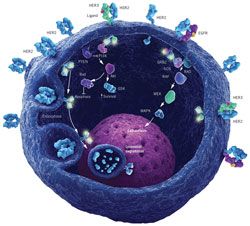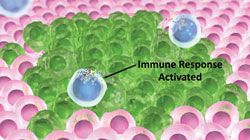Publication
Article
Oncology Live®
HER2 Signaling Beckons: Dimerization Process, Combination Therapies Highlight New Research
Author(s):
The first drug that successfully targeted the HER2 pathway in cancer treatment generated much excitement.

HER2 Pathway. Click to enlarge.
The first drug that successfully targeted the HER2 pathway in cancer treatment generated much excitement. In an unprecedented break from the typically sober language of scientific journals, the breast cancer drug Herceptin (trastuzumab) was touted as “a dramatic and perhaps permanent perturbation in the history of the disease, maybe even a cure” in a 2005 New England Journal of Medicine commentary on pivotal trial results.
Since its approval in 1998, Herceptin, which targets the HER2 protein, has become one of the most common therapeutic agents used in the treatment of breast cancer. Now, researchers are seeking to build upon the drug’s success by exploring its potential in combination therapy, sharpening the methods of identifying HER2 overexpression, and developing biomarkers to better identify patients who would benefit from the therapy.
How the HER2 Pathway Functions
HER2 is a member of the human epidermal growth factor receptor (EGFR) family, along with 3 other proteins: HER1 or EGFR, HER3, and HER4, all of which are receptor tyrosine kinases that feed into a complex biological signaling network controlling numerous cellular processes, including proliferation, survival, differentiation, angiogenesis, invasion, and metastasis.
Dimerization, the process through which two receptors such as HER2 join, plays a crucial role in receptor signaling. Multiple ligands bind to the different HER receptors with different binding specificity, exposing an extracellular dimerization domain and enabling 1 receptor molecule to pair with another.
The paired receptor molecules phosphorylate one another on tyrosine residues on their intracellular domains. The activated receptors are then able to bind to intracellular signaling molecules and initiate a variety of signaling pathways, including the phosphatidylinositol 3-kinase/protein kinase B (PI3K/Akt) pathway.
HER2 has no known ligand, and therefore relies for activation on heterodimerization with other HER receptors, or homodimerization with itself when it is expressed at very high levels on the cell surface. The HER2 receptor remains in a constitutively active conformation. Consequently, HER2 is the preferred partner for other members of the HER family.

Herceptin may activate an immune response, leading to cell death.
HER2 Signaling and Cancer Explored
HER2-containing heterodimers are the most prevalent and active of all the receptor pair combinations. For this reason, the HER2 signaling pathway is a target of significant interest for cancer researchers. Since the discovery of the HER2/neu oncogene in 1979, a high frequency and broad spectrum of aberrations in this pathway have been observed in human tumors.
Axel Ullrich, PhD, and H. Michael Shepard, PhD, researchers at the then-fledgling biotech company Genentech, identified the protein produced by this gene in 1984 and, together with Dennis Slamon, MD, PhD, discovered that the HER2 receptor is overexpressed in between 25% to 30% of breast cancers and is associated with more aggressive disease and a poorer outcome. More recent clinical data also support the role of HER2 in other tumor types, including gastric, thyroid, and head and neck cancers.

Defining the number of HER2 receptors remains controversial.
HER2-Targeted Therapies Take Shape
Interest in the HER2 pathway was stimulated, and in 1989, Ullrich and colleagues identified a monoclonal antibody that selectively bound to the extracellular domain of HER2, which specifically inhibited the growth of breast cancer cells overexpressing the HER2 receptor. This antibody was developed into the renowned drug trastuzumab (Herceptin, Genentech).
A wealth of clinical trials has demonstrated the efficacy of trastuzumab in combination with numerous chemotherapeutic agents. It became the first HER2-targeted therapy to gain FDA approval for the treatment of HER2-positive breast cancer. Landmark phase III trials reported in The New England Journal of Medicine in 2005 demonstrated that trastuzumab given after primary therapy (including surgery and chemotherapy) reduced recurrence rates by approximately 50%.
Despite the success of trastuzumab in treating both early- and advanced-stage HER2-positive breast cancer—at least as a single, first-line agent—it did not prove to be the “cure” that many hoped it would be, with objective response rates of only 26%. Furthermore, many patients treated with trastuzumab experience relapse or progression, mainly due to the development of drug resistance via a number of possible mechanisms.
First, trastuzumab does not block heterodimer formation, and therefore does not prevent ligand-dependent formation of the most potent HER2/HER3 signaling dimers. Second, a truncated form of HER2, known as p95, which lacks the extracellular domain to which trastuzumab binds, is commonly detected in HER2-positive breast cancer. Finally, secondary mutations in signaling components downstream of HER2, such as PI3K/Akt, may also drive trastuzumab resistance.
As a result, efforts are underway to develop other HER2-targeted therapies to overcome these issues. A small-molecule tyrosine kinase inhibitor (TKI), lapatinib (Tykerb, GlaxoSmithKline), is the only other HER2-targeted therapy currently on the market. It was approved as a second-line therapy for HER2-positive disease in 2007, following reports that its addition to capecitabine (Xeloda, Genentech) improved patient survival over capecitabine alone. Lapatinib is a dual-action TKI, targeting the intracellular domain of HER2 and HER1, and, as such, may be particularly useful in patients with p95 truncations.
New Generation in Development
Pertuzumab (Roche) is a humanized monoclonal antibody, the first in a new class of HER dimerization inhibitors. Pertuzumab binds to a different epitope of the HER2 extracellular domain than trastuzumab and is able to block HER2 dimerization. It is currently undergoing phase III clinical trials for use in combination with trastuzumab, following earlier trials suggesting that patients progressing while taking trastuzumab may benefit from the addition of pertuzumab therapy, with close to a 30% response rate.
Trastuzumab emtansine (T-DM1 [Roche Holding, AG]), an antibody-drug conjugate currently in development, is a combination of trastuzumab conjugated to a potent cytotoxic agent (mytansine derivative [ImmunoGen, Inc]) by a stable thioether linker. Clinical trials have demonstrated that trastuzumab-resistant patients are sensitive to this drug, with response rates of approximately 30%.
Other HER2-targeted therapies in development include: AEE788 (Novartis Pharmaceuticals), a multitargeted HER1/2 and vascular endothelial growth factor receptor inhibitor, currently in phase I and phase II trials; afatinib (Boehringer Ingelheim), an EGFR/HER2 inhibitor in phase III trials; and canertinib (Pfizer Inc), a pan-HER TKI, in phase II trials. Additionally, the HER2 TKIs CP-724, 714 (Axon Medchem BV) and neratinib (Pfizer Inc), and TAK-285 (Millennium/Takeda Pharmaceutical Company Ltd), a dual HER2/EGFR TKI, are currently undergoing phase I and phase II clinical development.
The kinetic pace of trastuzumab development highlights 2 significant findings that are already shaping the future of targeted therapies: (1) single agents are not sufficient to completely target complex signaling networks; numerous clinical trials are now exploring the efficacy of trastuzumab in combination with other targeted agents, including PI3K and Hsp90 inhibitors, as well as antiestrogen and antiangiogenic therapies; and (2) it is vital to identify patients who will most likely respond to targeted therapies via molecular testing.
Considerable controversy exists over defining HER2 overexpression. Studies suggest up to 20% of current HER2 testing worldwide may deliver false positives or false negatives, according to the American Society of Clinical Oncology (ASCO). Edith A. Perez, MD, deputy director of the Mayo Clinic Cancer Center in Jacksonville, Florida, aims to help settle this question through the North Central Cancer Treatment Group N9831 Adjuvant Trastuzumab Trial.
There are currently several FDA-approved methods for evaluating HER2 expression: fluorescence in situ hybridization (FISH) and immunohistochemistry via HerceptTest™ (Dako), or the HER2/neu rabbit monoclonal antibody test (Ventana Medical Systems, Inc).
The FDA recently approved a new test for detecting HER2 overexpression. New Genetic Test Aids Detection of HER2 Positive Breast Cancer
Key Research
- Adams CW, Allison DE, Flagella K, et al. Humanization of a recombinant monoclonal antibody to produce a therapeutic HER dimerization inhibitor, pertuzumab. Cancer Immunol Immunother. 2006;55: 717-727.
- Arteaga CL. Role of the HER2 pathway in cancer and cancer therapy. Medscape CME/CE. HER2 Lecture. Accessed May 28, 2011.
- Chang JC. HER2 inhibition: From discovery to clinical practice. Clin Cancer Res. 2007;13:1-3.
- De P, Leyland-Jones B. Whither HER2-related therapeutics? J Clin Oncol. 2010;28(7):1091-1096.
- Gutierrez C. and Schiff R. HER2: biology, detection and clinical implications. Arch Pathol Lab Med. 2011;135: 55-62.
- Hortobagyi GN. Trastuzumab in the treatment of breast cancer. N Engl J Med. 2005;353(16):1734-1736.
- Holbro T, Civenni G, Hynes NE. The ErbB receptors and their role in cancer progression. Exp Cell Res. 2003;284:99-110.
- Murphy CG, Modi S. HER2 breast cancer therapies: a review. Biologics: Targets & Therapy. 2009;3:289-301.
- Piccart-Gebhart MJ, Procter M, Leyland-Jones B, et al. Trastuzumab after adjuvant chemotherapy in HER2-positive breast cancer. N Engl J Med. 2005;353:1659-1672.
- Romond EH, Perez EA, Bryant J, et al. Trastuzumab plus adjuvant chemotherapy for operable HER2-positive breast cancer. N Engl J Med. 2005; 353(16):1673-1684.










